-
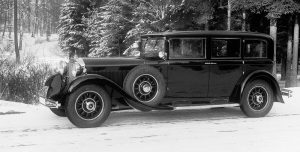
The Mercedes-Benz ‘Grand Mercedes’, 770 model (W 07), was the most luxurious car in the range of models being built in Stuttgart at that time. This top-class vehicle was available with or without a compressor, although only a few customers opted for the tamer version without a compressor. The photo shows a pullman saloon from 1931. Mercedes-Benz Nürburg, W 08 (1928 to 1933)
- Mercedes-Benz 770 ‘Super Mercedes’, W 07 and W 150 (1930 to 1943)
- Mercedes-Benz 320, W 142 (1937 to 1942)
The unique tradition of the Mercedes-Benz S-Class did not begin with the type 220 (W 187) in 1951; its roots stretch right back to the very origins of the Mercedes brand at the start of the 20th century. An early, eye-catching example is the Mercedes-Simplex 60 PS launched in 1903. The then top-of-the-range model is now one of the most spectacular exhibits in the Mercedes-Benz Classic collection. The elegant and luxurious touring sedan from 1904 was once owned by Emil Jellinek, a key protagonist in the early history of the Mercedes brand.
In the years to follow, the Mercedes and Benz sales ranges always included several high-end, luxury models. Even though open-top tourers were by far the most commonly-used body form during this period, the more powerful models were also offered as luxury sedans affording the ultimate in passenger comfort.
In the mid-1920s it was a different picture. Due to ever more powerful engines and increasing volumes of traffic, which the road-building programme was unable to keep up with, safe handling characteristics, a comfortable interior and optimum protection against wind, rain and dust were becoming more and more important. Saloons and Pullman saloons gradually began to replace the open-top tourers. The important high-end, luxury models of this era were the six-cylinder compressor 15/70/100 PS and 24/100/140 PS, produced under the Mercedes marque at the end of 1924. In 1926, the merger of the two previously independent companies founded by Carl Benz and Gottlieb Daimler led to the creation of Daimler-Benz AG, which added the first Mercedes-Benz production car with an eight-cylinder engine, the Nürburg 460 (W 08), to its model range in 1928. It remained in the sales programme – with continuous further development – until 1939. The last model was the type 500. From 1926 onwards, the entry-level vehicle in the Mercedes-Benz high-end range was the six-cylinder 12/55 PS, which was continually refined and developed through to the launch of the Mercedes-Benz Mannheim 370 (W 10) in 1931. The completely new Mercedes-Benz 290 (W 18) followed in 1933, but went on to be replaced by the type 320 (W 142) in 1937.
High-end saloons
In addition to vehicles from the high-end, luxury segment, Mercedes-Benz has always offered cars that represent a major advancement. They not only meet the highest standards in terms of safety, comfort and style: due to their status as an absolutely top-of-the-range model, extremely luxurious ambience and particularly opulent and spacious interior, they are primarily tailored to meet the requirements of individuals who need to, or have to, reflect their status in the choice of their vehicle, too. In this category was the Mercedes-Benz ‘Super Mercedes’ launched in 1930, also known as the type 770. Powered by a large-displacement eight-cylinder engine with supercharging, this top-of-the-range Mercedes-Benz model was used as an automotive statement, primarily by crowned and uncrowned heads of state and high-ranking figures from the world of industry and finance.
Mercedes-Benz Nürburg, W 08 (1928 to 1933)
-

Mercedes-Benz Nürburg 460 (W 08), pullman saloon version of 1928. First Mercedes-Benz series production car with an eight-cylinder engine
- Luxurious and spacious Pullman body
- High-speed transmission system as special equipment (from 1931, in conjunction with increased cubic capacity)
Mercedes-Benz 770 ‘Super Mercedes’, W 07 and W 150 (1930 to 1943)
- First Mercedes-Benz series production car with an 8-cylinder supercharged engine
- Dual ignition system with two spark plugs per cylinder (high-voltage magneto ignition and battery ignition)
- High-speed transmission system (five-speed manual transmission from 1938)
- Oval tubular box frame (from 1938)
- De Dion rear axle (from 1938)
Mercedes-Benz 320, W 142 (1937 to 1942)
- Smooth-running six-cylinder engine
- All-synchromesh four-speed transmission, with remote action gear from 1939
- Wide range of bodies: sedan, Pullman sedan (with exterior case from 1939), streamlined sedan, several convertibles
Gallery

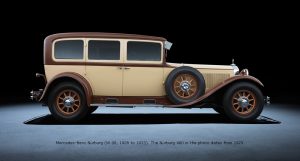

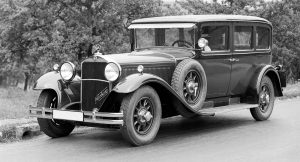
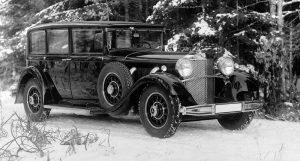
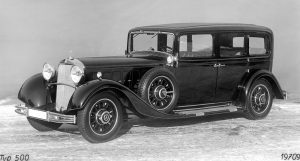
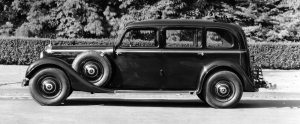
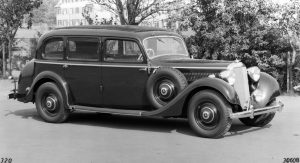
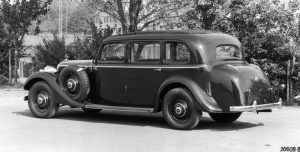


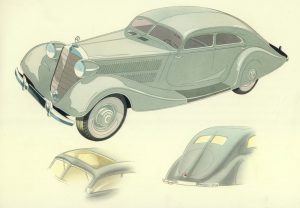

You must be logged in to post a comment.